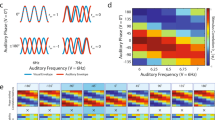Abstract
In two experiments, we examined whether or not pairs of auditory dimensions—timbre-loudness (Experiment 1) and timbre-pitch (Experiment 2)—interact in speeded classification. Subjects classified values from one dimension while the other dimension was (1) held constant (baseline), (2) varied orthogonally (filtering), or (3) correlated linearly. The subjects showed substantial Garner interference when classifying all dimensions—that is, poor performance at filtering relative to baseline. Timbre and loudness displayed redundancy gain (i.e., performance faster than baseline) when correlated positively, but redundancy loss (i.e., interference) when correlated negatively. Timbre and pitch displayed redundancy gain however dimensions were correlated. Both pairs of dimensions showed substantial effects of congruity: Attributes from one dimension were classified faster when paired with “congruent” attributes from the other dimension. The results are interpreted in terms of an interactive multichannel model of auditory processing.
Similar content being viewed by others
References
Ashby, F. G., &Townsend, J. T (1986). Varieties of perceptual independence.Psychological Review,93, 154–179.
Clark, H. H., &Brownell, H. H. (1975). Judging up and down.Journal of Experimental Psychology. Human Perception & Performance,1, 339–352
Clark, H. H., &Brownell, H. H. (1976). Position, direction, and their perceptual mtegrality.Perception & Psychophysics,19, 328–334.
DeValois, R. L., &DeValois, K. K. (1987).Spatial vision. New York. Oxford Umversity Press.
Durlach, N. I., Braida, L. D., &Ito, Y. (1986). Toward a model for discrinunation of broadband signals.Journal of the Acoustical Society of America,80, 63–72
Garner, W. R. (1974).The processing of information and structure Potomac, MD: Erlbaum.
Garner, W. R. (1981) The analysts of unanalyzed perceptions. In M Kubovy & J R. Pomerantz (Eds.),Perceptual organization (pp. 119–139). Hillsdale, NJ: Erlbaum.
Garner, W. R., &Felfoldy, G. L. (1970) Integrality of stimulus dimensions in various types of information processing.Cogninve Psychology,1, 225–241.
Graham, N. (1981). Psychophysics of spatial frequency channels. In M. Kubovy & J. R. Pomerantz (Eds.),Perceptual organization (pp. 1–26). Hillsdale, NJ: Erlbaum.
Grau, J. W., &Kemler-Nelson, D. G. (1988). The distinction between integral and separable dimensions: Evidence for the integrality of pitch and loudness.Journal of Experimental Psychology General,117, 347–370.
Green, D. M. (1988).Profile analysts. Auditory intensity discrimination New York: Oxford University Press
Hirsch, J., Hylton, R., &Graham, N. (1982). Simultaneous recognition of two spatial-frequency components.Vision Research,22, 365–375
Iverson, P., &Krumhansi, C. (1989). Pitch and timbre interaction in isolated tones and in sequencesJournal of the Acoustical Soctety, of America,86 (Suppl 1), S58.
LePage, E. L. (1987a) Frequency-dependent self-induced bias of the basilar membrane and its potential for controlling sensitivity and turing in the mamanalian cochlea.Journal of the Acoustical Society of America,82, 139–154.
Lepage, E. L. (1987b) A spatial template for the shape of tuning curves in the mammalian cochlea.Journal of the Acoustical Soctety of America,82, 155–164
Lockhead, G. R. (1966) Effects of dimensional redundancy on visual discrimination.Journal of Experimental Psychology,72, 95–104
Lockhead, G. R. (1972). Processing dimensional stimuli: A notePsychological Review,79, 410–419
Lockhead, G. R. (1979) Holistic versus analyttc process models: A reply.Journal of Experimental Psychology Human Perception & Performance,5, 746–755.
Marks, L. E. (1987) On cross-modal similanty: Auditory-visual interactions in speeded discrimination.Journal of Experimental Psychology: Human Perception & Performance,13, 384–394
Marks, L. E., Hamseal, R. J., & Bornstein, M. H. (1987). Perceiving similarity and comprehending metaphor.Monographs of the Society for Research in Child Development,52(1, Serial No. 215).
Melara, R. D. (1989a) Dimensional interaction between color and pitchJournal of Experimental Psychology Human Percepnon & Performance,15, 69–79.
Melara, R. D (1989b). Similarity relations among synesthetic stimuli and their attributesJournal of Erperimental Psychology Human Perception & Performance,15, 212–231.
Melara, R. D., & Marks, L. E. (1990a) Dimenstonal interactions in language processmg Investigating directlons and levels of crosstalk.Journal of Experimental Psychology: Learning, Memory, & Cognition
Melara, R. D., &Marks, L. E. (1990b).Hard andSoft interacting dimensions: Differential effects of dual context on classification.Perception & Psychophysics,47, 307–325.
Melara, R. D., & Marks, L. E. (1990c). Perceptual primacy of dimensions Support for a model of dimensional interaction.Journal of Experimental Psychology. Human Perception & Performance.
Melara, R. D., & Marks, L. E. (in press). Processes underlying dimensional interactions: Correspondences between linguistic and nonlinguistic dimensions.Memory & Cognition.
Melara.,R. D., &O’Brien T. P. (1987). Interaction between synesthetically corresponding dimensions.Journal of Experimental Psychology: General,116, 323–336.
Pomerantz, J. R. (1983). Global and local precedence: Selective attention in form and motion perception.Journal of Experimental Psychology General,112, 515–540
Pomerantz, J. R. (1986). Visual form perception: An overview In E. C. Schwab & H. C. Nusbaum (Eds.),Pattern recognition by humans and machines: Visual perception (pp 1–30). New York Academic Press
Pomerantz, J. R., Pristach, E. A., &Carson, C. E. (1989). Attennon and object perception. In B. E. Shepp & S. Ballesteros (Eds.),Object perception Structure and process (pp. 53–89). Hillsdale, NJ. Erlbaum.
Poner, M. I (1964) Information reduction in the analysis of sequential tasks.Psychological Review,71, 491–504.
Price, J. M. (1979). Software timing for 6500 series microcomputers.Behavior Research Methods & Instrumentation,11, 568–571.
Walker, P., &Smith, S. (1984). Stroop interference based on the synesthetic qualities of auditory pitch.Perception,13, 75–81.
Walker, P., &Smith, S. (1986). The basis of Stroop interference involving the multimodal correlates of auditory pitch.Perception,15, 491–496.
Wood, C. C. (1975). Auditory and phonetic levels of processing in speech perception: Neurophysiological and Information-processing analyses.Journal of Experimental Psychology: Human Perception & Performance,1, 3–20.
Zwicker, E. (1986). A hardware cochlear nonlinear preprocessmg model with active feedback.Journal of the Acoustical Society of America,80, 146–153.
Author information
Authors and Affiliations
Additional information
Preparauon of this arlacle was supported by Nataonal Inslatutes of Health (NIH) Postdoctoral Fellowship HD07137 and NIH Grant NS28617 to Robert Melara and by NIH Grant DC00271 and National Science Foundation Grant BNS84-20017 to Lawrence Marks
Rights and permissions
About this article
Cite this article
Melara, R.D., Marks, L.E. Interaction among auditory dimensions: Timbre, pitch, and loudness. Perception & Psychophysics 48, 169–178 (1990). https://doi.org/10.3758/BF03207084
Received:
Accepted:
Published:
Issue Date:
DOI: https://doi.org/10.3758/BF03207084




